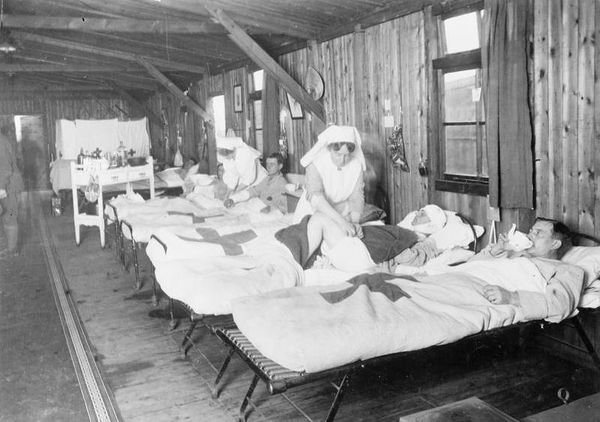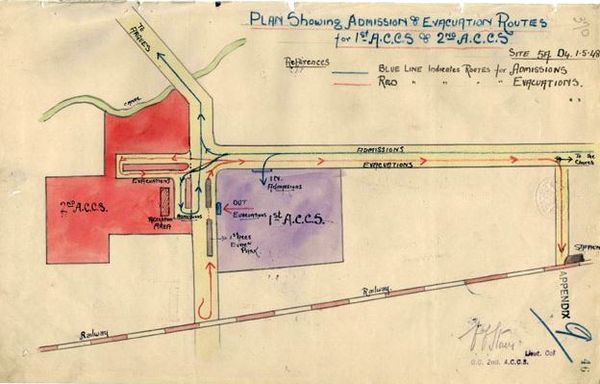Difference between revisions of "2nd Australian Casualty Clearing Station"
From Our Contribution
(Created page with "{{Infobox | name = 2nd Australian Casualty Clearing Station | title = | above = | subheader = | image = File:2nd_ACCS_Steenwer...") |
(→Patients) |
||
| Line 56: | Line 56: | ||
==Patients== | ==Patients== | ||
| + | |||
| + | *[[Albert Edgar Bishop]] 2 Nov 1917 | ||
| + | |||
| + | |||
[[Category:Hospitals]] | [[Category:Hospitals]] | ||
Revision as of 01:02, 20 November 2017
General Information
During Spring 1917 the work for Casualty Clearing Stations was normal, but in May and June 1917, it became heavier, and additional staff was sent up from No.2 Australian General Hospital, increasing the Nursing Staff to 14. In July, the Sister-in-Charge wrote that they had 3 operating tables in use throughout the day, and usually two at night. During July and August almost 2000 operations were performed in this unit alone.
It was in July that the C.C.S. was bombed, and the 4 Sisters were awarded the Military Medal. At this time the C.C.S. received many patients from mustard gas attacks. The Sister-in-Charge wrote “Mustard oil shells are being used by the enemy, in consequence of which we receive many patients with burns therefrom, the eyes specially being much inflamed. At times, large blisters form on the body”.
In Sep 1917 the C.C.S. was under shell fire several times and once a large piece of shell pierced the roof of the theatre, and bent the operating table, but fortunately no one was operating at the time. Night bombing raids were also quite frequent. A bomb-proof shelter was built for the Sisters who slept there on moonlight nights. The heavy work continued up to the end of the year, and a great deal of night work was done, it being quite a usual thing for 2 or 3 surgical teams to work through the night.
On 11 May 18 hostile shelling was closer than usual, and orders were given for the unit to pack up preparatory to a move. All the patients were evacuated and the Nursing Staff left in motor ambulances for 10 Stationary Hospital. On 5 Apr 1918 the C.C.S. returned to a new site, Ana Jana, near Hazebrouck, and on the 9th, work commenced with a great rush. On the 12th, after only 3½ days work at this new Hospital, during which over 1000 cases had been received, orders were given to pack up again, and to be ready to move off by nightfall. The report of the Sister-in-Charge says: “All worked up to the last minute and patients were quickly evacuated. We Sisters, left on this occasion in an old London double-decker bus, Sisters on top, and all out luggage stowed inside.
This journey, again to No.10 Stationary Hospital was anything but a pleasant one. The roads were extremely bad, traffic very heavy and the sight of hundreds of refugees streaming along, carrying their all, was heart-rending.” On the same night there was a terrible air-raid over St. Omer, many civilians killed, and buildings wrecked.
On 17 Apr 1918 No.2 Australian CCS re-opened at Blendeques and work commenced on the 26th, though with not quite such a tremendous rush as there had been at Ana Jana. Anzac Day (April 26th) was celebrated by a Church Service in the morning and sports in the afternoon.
In September 1918, the units moved (with No.1 Australian C.C.S.) to the Asylum at St. Venant and was taken over by the 5th Army. From there they moved on 12 Oct 1918 to Nouveau Monde, near Estaires, but did not remain there long, as the Army was rapidly advancing. On 14 Nov 1918 they moved to Tournai where they occupied the Asylum building, and on 18 Dec 1918 they moved once more, to Ath, where they established themselves in a civil Hospital.
On 27 Feb 1919 orders were received for the unit to hand over to a British Field Ambulance and to proceed to the Base for demobilisation. A staff of British Sisters took over the Hospital, and the Australian Sisters rejoined their Base units, prior to being demobilised.
Staff
Patients
- Albert Edgar Bishop 2 Nov 1917

